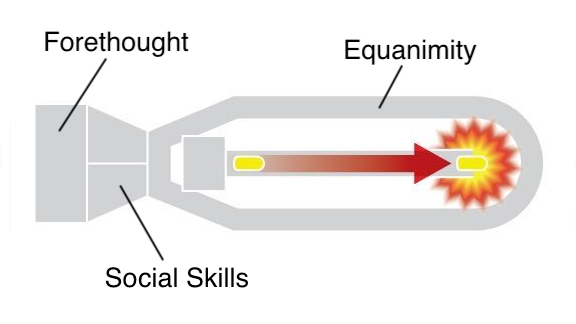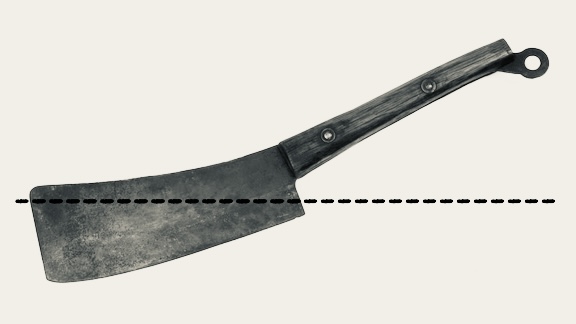Gandhi with a Nuclear Weapon
 If a killer kills someone, no one is much surprised. Likewise, if the killer is killed by their intended victim, it’s just “job well done.” But if no one meant to kill anyone, and someone ends up dead, well, then it’s cartoon exclamation points all around. Everyone, including the newly-minted killer, is surprised. Cries of “How could this happen?” and “But I didn’t want to kill him!” ring out. In the end it gets labeled as an unfortunate accident.
If a killer kills someone, no one is much surprised. Likewise, if the killer is killed by their intended victim, it’s just “job well done.” But if no one meant to kill anyone, and someone ends up dead, well, then it’s cartoon exclamation points all around. Everyone, including the newly-minted killer, is surprised. Cries of “How could this happen?” and “But I didn’t want to kill him!” ring out. In the end it gets labeled as an unfortunate accident.
But these “accidents” happen often enough that when a new one pops up, I can still recall the last one I read about. Primates have a territorial dispute, and begin vocalizing at each other to communicate their displeasure, then aggression in a sideways request that the other capitulate. When neither one backs down, it goes to blows, again to run the interloper off. Usually, this works out fine, as nature intended. But when it’s bodyweight + brain + concrete, one can end up running their rival not just off their territory, but off this mortal coil entire.
These things happen often enough that I would suspect you’re more likely, on balance, to be involved in this sort of situation than purely asocial violence. In other words, you’re much more likely to get slapped at than outright murdered. Misery comes from confusing the two.
If you train to kill and think that means you’re physically trained to handle the antisocial, it’s the same as carrying a gun in case you get into an argument.
If you train to kill and think that means you get to ignore the antisocial, you’re setting yourself up to be ready for the most unlikely event while ignoring the most likely. Chances are, you’re going to get caught wanting.
Because we train to use our bodies to cause injury, it’s easy for people to get the wrong idea—on the surface, martial arts and combat sports look similar to what we do. And since martial arts and combat sports do a great job of preparing folks to navigate that antisocial fog-zone, they then tend to think we’re training for the same thing, only in a “super effective” way. That’s like pulling a gun in a bar fight and “shooting to subdue”. There’s no such thing.
Still, people get all eager to lock horns. It’s funny to me (funny-strange, not funny-ha-ha) seeing as how we can still end up with unintended fatalities. If you ask a civilian gun owner, “How many gunfights do you want to be in?” the sane ones will all tell you, “None.” The sane ones understand what goes on in a gunfight, and would never choose to be there if they didn’t have to. If they should find themselves there, they will shoot to kill. But sane civilians don’t walk around looking for gunfights.
Again, this is painfully obvious when we talk about guns. But for some reason it’s less obvious with empty hands. Why? It comes down to expectations. We expect someone to die if a gun is involved—that’s what the modern handgun is for, killing people at close range. We don’t expect someone to die from a standard, everyday session of monkey politics. And yet death is one of the possible outcomes.
Me, I expect someone to die every time violence is used, and then breathe a sigh of relief when everyone survives. I have absolutely no interest in going physical with monkey politics. I don’t leave the house looking for opportunities to use my skills.
My aversion to violence runs so strong that it makes me something of a walking contradiction to my friends—I will do whatever I can to avoid physical, antisocial confrontation and yet won’t hesitate to stomp someone into the morgue in the asocial realm. I’m like Gandhi with a nuclear weapon.
For those of you feeling eager, or emboldened by your training, some advice:
You’re all set for the asocial. If someone wants to murder you, you’re well-prepared—knowledgeable, practiced, resolute. But don’t forget to make sure you’re prepared for the antisocial—sharpen those social skills, actively think about how you want to be in those situations. Will you join in and play along? Throw fuel on the fire? Push until they either back down or go after you? Or will you go completely sideways on them, defusing the situation, seeking to reduce their fear and channel their anger elsewhere?
Know where your buttons are and put lots of padding between them and the outside world. Work to recognize when you’re being pushed into a corner. And remember that simply walking away could save your life—or keep you out of prison.
As with the asocial, so with the antisocial: be prepared.
Chances are you’ll go your entire life without anyone trying to kill you. I wouldn’t make the same bet about some jerk calling you out.
— Chris Ranck-Buhr (from 2008)







